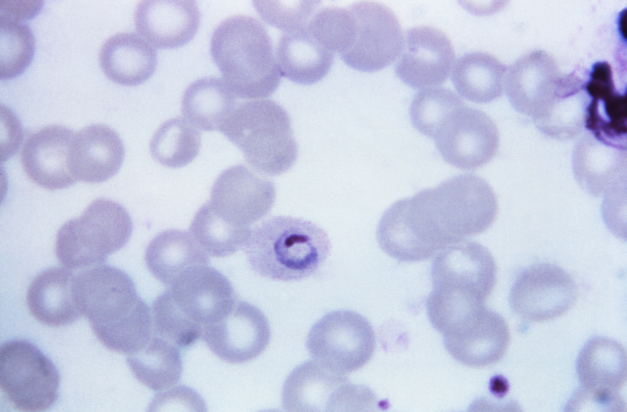Plasmodium ovale
| Plasmodium ovale | ||||||||||||||
|---|---|---|---|---|---|---|---|---|---|---|---|---|---|---|
 Plasmodium ovale trophozoite, Giemsa stain.
| ||||||||||||||
| Scientific classification | ||||||||||||||
| ||||||||||||||
| Binomial name | ||||||||||||||
| Plasmodium ovale Stephens 1922 |
Plasmodium ovale is a species of parasitic protozoa that causes tertian malaria in humans. It is closely related to Plasmodium falciparum and Plasmodium vivax, which are responsible for most malaria. It is rare compared to these two parasites, and substantially less dangerous than P. falciparum.
Epidemiology
P. ovale is very limited in its range. It is endemic mainly to West Africa, the Philippines, eastern Indonesia, and Papua New Guinea.[1]
Diagnosis
The microscopic appearance of P. ovale is very similar to that of P. vivax and if there are only a small number of parasites seen, it may be impossible to distinguish the two species on morphological grounds alone. There is no difference between the medical treatment of P. ovale and P. vivax, and therefore some laboratory diagnoses report "P. vivax/ovale", which is perfectly acceptable as treatment for the two are very similar. Schüffner's dots are seen on the surface of the parasitised red blood cell, but these are larger and darker than in P. vivax and are sometimes called "James's dots". About twenty percent of the parasitized cells are oval in shape (hence the species name) and some of the oval cells also have fimbriated edges (the so-called "comet cell"). The mature schizonts of P. ovale never have more than twelve nuclei within them and this is the only reliable way of distinguishing between the two species.
P. vivax and P. ovale that has been sitting in EDTA for more than half-an-hour before the blood film is made will look very similar in appearance to P. malariae, which is an important reason to warn the laboratory immediately when the blood sample is drawn so they can process the sample as soon as it arrives.
Treatment
Standard treatment is concurrent treatment with chloroquine and primaquine. The combination atovaquone-proguanil may be used in those patients who are unable to take chloroquine for whatever reason.[2]
References
- ↑ Baird KJ and Hoffman SL (2004). "Primaquine Therapy for Malaria". Clin Infect Dis. 39: 1336&ndash, 1345.
- ↑ Radloff PD, Philipps J, Hutchinson D, Kremsner PG (1996). "Atovaquone plus proguanil is an effective treatment for Plasmodium ovale and P. malariae malaria". Trans R Soc Trop Med Hyg. 90 (6): 682. PMID 9015517.